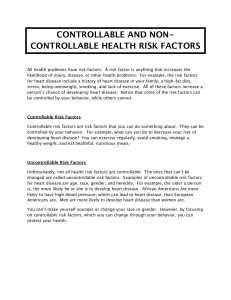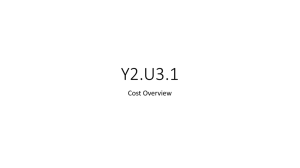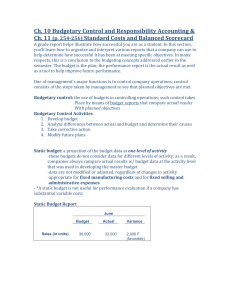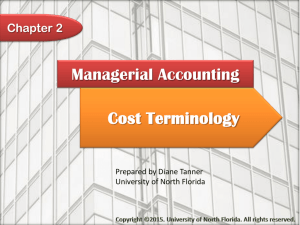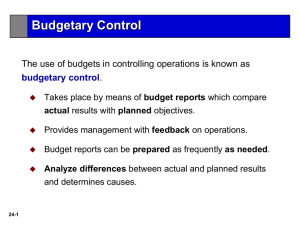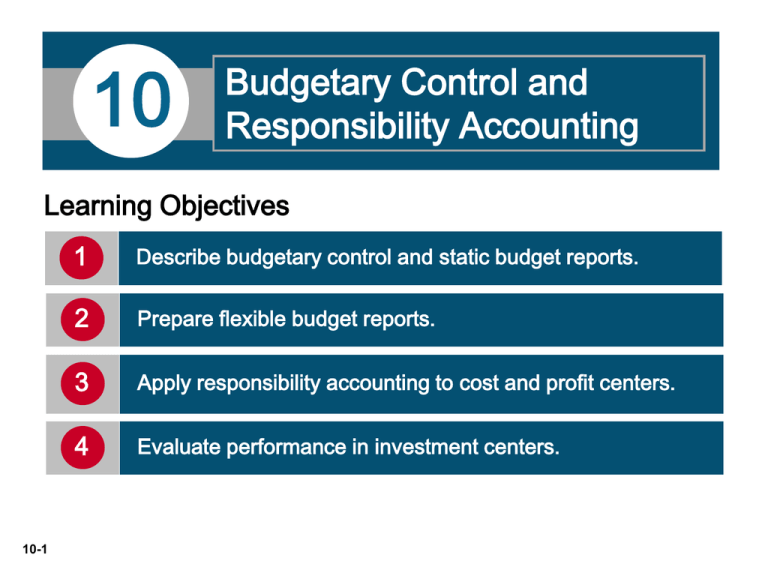
10
Budgetary Control and
Responsibility Accounting
Learning Objectives
10-1
1
Describe budgetary control and static budget reports.
2
Prepare flexible budget reports.
3
Apply responsibility accounting to cost and profit centers.
4
Evaluate performance in investment centers.
LEARNING
OBJECTIVE
1
Describe budgetary control and static budget
reports.
The use of budgets in controlling operations is known as
budgetary control.
Takes place by means of budget reports which compare
actual results with planned objectives.
Provides management with feedback on operations.
Budget reports can be prepared as frequently as needed.
Management analyzes differences between actual and
planned results and determines causes.
10-2
LO 1
Budgetary Control
Budgetary control involves the following activities.
Illustration 10-1
10-3
LO 1
Budgetary Control
Works best when a company has a formalized reporting
system which:
1. Identifies the name of the budget report.
2. States the frequency of the report.
3. Specifies the purpose of the report.
4. Indicates the primary recipient(s) of the report.
10-4
LO 1
Budgetary Control
Partial budgetary control system for manufacturing company.
Illustration 10-2
10-5
LO 1
Budgetary Control
Question
Budgetary control involves all but one of the following:
a. Modifying future plans.
b. Analyzing differences.
c. Using static budgets.
d. Determining differences between actual and planned
results.
10-6
LO 1
Static Budget Reports
A Static budget is a projection of budget data at one level
of activity.
When used in budgetary control, each budget included
in the master budget is considered to be static.
Ignores data for different levels of activity.
Compares actual results with budget data at the activity
level used in the master budget.
10-7
LO 1
Static Budget Reports
Illustration: Budget and actual sales data for the Rightride
product in the first and second quarters of 2017 are as
follows.
Illustration 10-3
10-8
LO 1
Static Budget Reports
Illustration: Sales budget report for Hayes Company’s first
quarter.
Illustration 10-3
Illustration 10-4
10-9
LO 1
Static Budget Reports
Illustration: Budget report for the second quarter contains
one new feature: cumulative year-to-date information.
Illustration 10-3
Illustration 10-5
10-10
LO 1
Static Budget Reports
USES AND LIMITATIONS
10-11
Appropriate for evaluating a manager’s effectiveness in
controlling costs when:
►
Actual level of activity closely
approximates master budget
activity level, and/or
►
Behavior of costs is fixed in
response to changes in activity.
Appropriate for fixed costs.
Not appropriate for variable costs.
LO 1
Static Budget Reports
Question
A static budget is useful in controlling costs when cost
behavior is:
a. Mixed.
b. Fixed.
c. Variable.
d. Linear.
10-12
LO 1
DO IT! 1
Static Budget Report
Lawler Company expects to produce 5,000 units of product CV93
during the current month. Budgeted variable manufacturing costs per
unit are direct materials $6, direct labor $15, and overhead $24.
Monthly budgeted fixed manufacturing overhead costs are $10,000 for
depreciation and $5,000 for supervision.
In the current month, Lawler actually produced 5,500 units and
incurred the following costs: direct materials $33,900, direct labor
$74,200, variable overhead $120,500, depreciation $10,000, and
supervision $5,000.
Prepare a static budget report. (Hint: The Budget column is based on
estimated production of 5,000 units while the Actual column is the
actual costs incurred during the period.)
10-13
LO 1
DO IT! 1
Static Budget Report
Solution
10-14
LO 1
LEARNING
OBJECTIVE
2
Prepare flexible budget reports.
Flexible budget projects budget data for various levels of
activity.
Essentially a series of static budgets at
different activity levels.
Budgetary process more useful if it is
adaptable to changes in operating
conditions.
Can be prepared for each type of
budget in the master budget.
10-15
LO 2
Why Flexible Budgets?
Illustration: Barton Robotics, static budget based on a production
volume of 10,000 units of robotic controls.
Illustration 10-6
10-16
LO 2
Illustration: Overhead Static Budget report assuming 12,000 units
were actually produced, rather than 10,000 units.
10-17
Illustration 10-7
LO 2
Why Flexible Budgets?
Over budget in three of six overhead costs.
►
Unfavorable difference of $132,000 – 12% over budget.
Comparison based on budget data for 10,000 units - the
original activity level which is not relevant.
►
Meaningless to compare actual variable costs for 12,000
units with budgeted variable costs for 10,000 units.
►
Variable cost increase with production.
Budgeted variable amounts should increase
proportionately with production
10-18
LO 2
Why Flexible Budgets?
Illustration: Analyzing the budget data for these costs at 10,000 units,
you arrive at the following per unit results.
Illustration 10-8
Variable costs
per unit
Illustration 10-9
Budgeted variable
costs, 12,000
units
10-19
LO 2
Illustration: Prepare the budget report based on the flexible budget for
12,000 units of production.
Illustration 10-10
10-20
Developing the Flexible Budget
1. Identify the activity index and the relevant range of
activity.
2. Identify the variable costs and determine the budgeted
variable cost per unit of activity for each cost.
3. Identify the fixed costs and determine the budgeted
amount for each cost.
4. Prepare the budget for selected increments of activity
within the relevant range.
10-21
LO 2
Service Company Insight
NBC Universal
Just What the Doctor Ordered?
Nobody is immune from the effects of declining revenues—not even
movie stars. When the number of viewers of the television show
“House,” a medical drama, declined by almost 20%, Fox Broadcasting
said it wanted to cut the license fee that it paid to NBC Universal by
20%. What would NBC Universal do in response? It might cut the size
of the show’s cast, which would reduce the payroll costs associated with
the show. Or, it could reduce the number of episodes that take
advantage of the full cast. Alternatively, it might threaten to quit
providing the show to Fox altogether and instead present the show on
its own NBC-affiliated channels.
Source: Sam Schechner, “Media Business Shorts: NBCU, Fox Taking Scalpel to
‘House’,” Wall Street Journal Online (April 17, 2011).
10-22
LO 2
Flexible Budget – A Case Study
Illustration: Fox Company’s management uses a flexible budget
for monthly comparisons of actual and budgeted manufacturing
overhead costs of the Finishing Department. The master budget
for the year ending December 31, 2017, shows expected annual
operating capacity of 120,000 direct labor hours and the following
overhead costs.
Illustration 10-11
10-23
LO 2
Flexible Budget – A Case Study
Four steps for developing the flexible budget.
1. Identify the activity index and the relevant range of activity.
►
Activity index: direct labor hours.
►
Relevant range: 8,000 – 12,000 direct labor hours per month.
2. Identify variable costs and determine the budgeted variable
cost per unit of activity for each cost.
Illustration 10-12
10-24
LO 2
Flexible Budget – A Case Study
Four steps for developing the flexible budget.
3. Identify the fixed costs and determine the budgeted amount
for each cost.
►
Three fixed costs per month:
Depreciation $15,000.
Supervision $10,000.
Property taxes $5,000.
4. Prepare the budget for selected increments of activity within
the relevant range.
►
10-25
Prepared in increments of 1,000 direct labor hours.
LO 2
Monthly overhead flexible budget
10-26
Illustration 10-13
LO 2
Flexible Budget – A Case Study
Fox uses the formula below to determine total budgeted costs at
any level of activity.
Illustration 10-14
Determine total budgeted costs for Fox Manufacturing Company with
fixed costs of $30,000 and total variable cost $4 per direct labor
hour:
10-27
9,000 direct labor hours : $30,000 + ($4 x 9,000) = $66,000
8,622 direct labor hours: $30,000 + ($4 x 8,622) = $64,488
LO 2
Flexible Budget – A Case Study
Graphic flexible budget data highlighting 10,000 and 12,000
activity levels.
Illustration 10-15
10-28
LO 2
Flexible Budget Reports
Widely used in production and service departments.
A type of internal report.
Consists of two sections:
►
Production data for a selected activity index, such as
direct labor hours.
►
Cost data for variable and fixed costs.
Widely used in production and service departments to
evaluate a manager’s performance.
10-29
LO 2
10-30
Illustration 10-16
LO 2
Service Company Insight
San Diego Zoo
Budgets and the Exotic Newcastle Disease
Exotic Newcastle Disease, one of the most infectious bird diseases in
the world, kills so swiftly that many victims die before any symptoms
appear. When it broke out in Southern California, it could have spelled
disaster for the San Diego Zoo. “We have one of the most valuable
collections of birds in the world, if not the most valuable,” says Paula
Brock, CFO of the Zoological Society of San Diego, which operates the
zoo. Bird exhibits were closed to the public for several months (the
disease, which is harmless to humans, can be carried on clothes and
shoes). The tires of arriving delivery trucks were sanitized, as were the
shoes of anyone visiting the zoo’s nonpublic areas. Zookeeper uniforms
had to be changed and cleaned daily. And ultimately, the zoo, with
$150 million in revenues, spent almost half a million dollars on
quarantine measures.
10-31
LO 2
Service Company Insight
San Diego Zoo
Budgets and the Exotic Newcastle Disease
It worked: No birds got sick. Better yet, the damage to the rest of the
zoo’s budget was minimized by another protective measure: the
monthly budget reforecast. “When we get a hit like this, we still have to
find a way to make our bottom line,” says Brock. Thanks to a new
planning process Brock had introduced a year earlier, the zoo’s
scientists were able to raise the financial alarm as they redirected
resources to ward off the disease. “Because we had timely awareness,”
she says, “we were able to make adjustments to weather the storm.”
Source: Tim Reason, “Budgeting in the Real World,” CFO Magazine (July 12,
2005),www.cfodirect.com/cfopublic.nsf/vContentPrint/
649A82C8FF8AB06B85257037004 (accessed July 2005).
10-32
LO 2
Flexible Budgets
Question
At 9,000 direct labor hours, the flexible budget for indirect
materials is $27,000. If $28,000 of indirect materials costs are
incurred at 9,200 direct labor hours, the flexible budget report
should show the following difference for indirect materials:
10-33
a.
$1,000 unfavorable.
b.
$1,000 favorable.
c.
$400 favorable.
d.
$400 unfavorable.
LO 2
DO IT! 2
Flexible Budgets
In Strassel Company’s
flexible budget graph,
the fixed cost line and
the total budgeted cost
line intersect the
vertical axis at $36,000.
The total budgeted cost
line is $186,000 at an
activity level of 50,000
direct labor hours.
Compute total budgeted
costs at 30,000 direct
labor hours.
10-34
LO 2
DO IT! 2
Flexible Budgets
In Strassel Company’s flexible budget graph, the fixed cost line and the
total budgeted cost line intersect the vertical axis at $36,000. The total
budgeted cost line is $186,000 at an activity level of 50,000 direct labor
hours. Compute total budgeted costs at 30,000 direct labor hours.
Variable costs:
Total budgeted cost line
Fixed costs
Variable costs at 50,000 hours
Activity level at intersect (hours)
Variable costs per direct labor hour
Direct labor hours
Total variable costs
Total fixed costs
Total budgeted costs
10-35
$ 186,000
- 36,000
150,000
÷ 50,000
$3
x 30,000
90,000
+ 36,000
$ 126,000
LO 2
LEARNING
OBJECTIVE
3
Apply responsibility accounting to cost and
profit centers.
Accumulating and reporting costs (and revenues, where
relevant) on the basis of the manager who has the authority to
make the day-to-day decisions about the items.
Conditions:
1. Costs and revenues can be directly associated with the
specific level of management responsibility.
2. Costs and revenues can be controlled by employees at the
level of responsibility with which they are associated.
3. Budget data can be developed for evaluating the manager’s
effectiveness in controlling the costs and revenues.
10-36
LO 3
Responsibility Accounting
Levels of responsibility for controlling costs.
Illustration 10-17
10-37
LO 3
Responsibility Accounting
10-38
Responsibility center - any individual who has control and
is accountable for activities.
May extend to any level of management.
Especially valuable in a decentralized company.
►
Control of operations delegated to many managers
throughout the organization.
►
Segment – area of responsibility for which reports are
prepared.
LO 3
Responsibility Accounting
Two differences from budgeting in reporting costs and
revenues:
1. Distinguishes between controllable and noncontrollable
costs.
2. Emphasizes or includes only items controllable by the
individual manager in performance reports.
10-39
Applies to both profit and not-for-profit entities.
►
Profit entities: maximize net income.
►
Not-for-profit: minimize cost of providing services.
LO 3
Management Insight
Proctor & Gamble
Competition versus Collaboration
Many compensation and promotion programs encourage competition
among employees for pay raises. To get ahead, you have to perform
better than your fellow employees. While this may encourage hard work,
it does not foster collaboration, and it can lead to distrust and disloyalty.
Such negative effects have led some companies to believe that
cooperation and collaboration, not competition, are essential in order to
succeed in today’s work environment. As a consequence, many
companies now explicitly include measures of collaboration in their
performance measures. For example, Procter & Gamble measures
collaboration in employees’ annual performance reviews. At Cisco
Systems, the assessment of an employee’s teamwork can affect the
annual bonus by as much as 20%.
Source: Carol Hymowitz, “Rewarding Competitors Over Collaboration No
Longer Makes Sense,” Wall Street Journal (February 13, 2006).
10-40
LO 3
Controllable Versus Noncontrollable
Revenues and Costs
Critical issue is whether the cost or revenue is controllable at
the level of responsibility with which it is associated. A cost
over which a manager has control is called a controllable cost.
1. All costs are controllable by top management.
2. Fewer costs are controllable as one moves down to each
lower level of managerial responsibility.
Costs incurred indirectly and allocated to a responsibility level
are noncontrollable costs.
10-41
LO 3
Principles of Performance Evaluations
10-42
Management function that compares actual results
with budget goals.
Includes both behavioral and reporting principles.
LO 3
Principles of Performance Evaluation
MANAGEMENT BY EXCEPTION
Management by exception means that top management’s
review of a budget report is focused primarily on differences
between actual results and planned objectives.
MATERIALITY - Without quantitative guidelines,
management would have to investigate every budget
difference regardless of the amount.
CONTROLLABILITY OF THE ITEM - Exception guidelines
are more restrictive for controllable items than for items the
manager cannot control.
10-43
LO 3
Principles of Performance Evaluation
BEHAVIORAL PRINCIPLES
1. Managers of responsibility centers should have direct input
into the process of establishing budget goals of their area of
responsibility.
2. The evaluation of performance should be based entirely on
matters that are controllable by the manager being
evaluated.
3. Top management should support the evaluation process.
4. The evaluation process must allow managers to respond to
their evaluations.
5. The evaluation should identify both good and poor
performance.
10-44
LO 3
Principles of Performance Evaluation
REPORTING PRINCIPLES
1. Contain only data controllable by manager of responsibility
center.
2. Provide accurate and reliable budget data to measure
performance.
3. Highlight significant differences between actual results and
budget goals.
4. Be tailor-made for intended evaluation.
5. Be prepared at reasonable intervals.
10-45
LO 3
Management Insight
Honda
Flexible Manufacturing Requires Flexible Accounting
Flexible budgeting is useful because it enables managers to evaluate
performance in light of changing conditions. But the ability to react quickly to
changing conditions is even more important. Among automobile manufacturing
facilities in the U.S., few plants are more flexible than Honda. The
manufacturing facilities of some auto companies can make slight alterations to
the features of a vehicle in response to changes in demand for particular
features. But for most plants, to switch from production of one type of vehicle to
a completely different one typically takes months and costs hundreds of millions
of dollars. At the Honda plant, however, the switch takes minutes. For example,
it takes about five minutes to install different hand-like parts on the robots so
they can switch from making Civic compacts to the longer, taller CR-V
crossover. This ability to adjust quickly to changing demand gave Honda a huge
advantage when gas prices surged and demand for more fuel-efficient cars
increased quickly.
Source: Kate Linebaugh, “Honda’s Flexible Plants Provide Edge,” Wall Street Journal
Online (September 23, 2008).
10-46
LO 3
Responsibility Reporting System
Involves preparation of a report for each level of
responsibility in the company's organization chart.
Begins with the lowest level of responsibility and moves
upward to higher levels.
Permits management by exception at each level of
responsibility.
Each higher level can obtain the detailed report for
each lower level.
10-47
LO 3
Illustration 10-18
Partial organization chart
10-48
LO 3
Responsibility
Reporting
Illustration 10-19
Responsibility reporting system
Permits comparative
evaluations.
Plant manager can rank
each department
manager’s effectiveness
in controlling
manufacturing costs.
10-49
Comparative rankings
provide incentive for a
manager to control costs.
Report A
President sees
summary
data of vice
presidents.
Report B
Vice president sees
summary of controllable
costs in his/her functional
area.
Report C
Plant manager sees
summary of controllable
costs for each department
in the plant.
Report D
Department manager sees
controllable costs of his/her
department.
Illustration 10-19
Responsibility reporting
system
Report A
President sees
summary data of
vice presidents.
Report B
Vice president sees
summary of
controllable costs in
his/her functional
area.
10-50
Illustration 10-19
Responsibility reporting
system
Report B
Vice president
sees summary of
controllable costs
in his/her
functional area.
Report C
Plant manager sees
summary of
controllable costs
for each department
in the plant.
10-51
Illustration 10-19
Responsibility reporting
system
Report C
Plant manager
sees summary of
controllable costs
for each
department in the
plant.
Report D
Department
manager sees
controllable costs of
his/her department.
10-52
LO 3
Types of Responsibility Centers
Three basic types:
10-53
Cost center
►
Incurs costs but does not directly generate revenues.
►
Managers have authority to incur costs.
►
Managers evaluated on ability to control costs.
►
Usually a production department or a service
department.
Profit center
Investment center
LO 3
Types of Responsibility Centers
Three basic types:
Cost center
Profit center
10-54
►
Incurs costs and generates revenues.
►
Managers judged on profitability of center.
►
Examples include individual departments of a retail
store or branch bank offices.
Investment center
LO 3
Types of Responsibility Centers
Three basic types:
10-55
Cost center
Profit center
Investment center
►
Incurs costs, generates revenues, and has investment
funds available for use.
►
Manager evaluated on profitability of the center and rate
of return earned on funds.
►
Often a subsidiary company or a product line.
►
Manager able to control or significantly influence
investment decisions such as plant expansion.
LO 3
Types of Responsibility Centers
Illustration 10-20
10-56
LO 3
Types of Responsibility Centers
Question
Under responsibility accounting, the evaluation of a
manager’s performance is based on matters that the
manager:
10-57
a.
Directly controls.
b.
Directly and indirectly controls.
c.
Indirectly controls.
d.
Has shared responsibility for with another manager.
LO 3
Types of Responsibility Centers
RESPONSIBILITY ACCOUNTING FOR COST
CENTERS
Based on a manager’s ability to meet budgeted goals
for controllable costs.
Results in responsibility reports which compare actual
controllable costs with flexible budget data.
10-58
►
Include only controllable costs in reports.
►
No distinction between variable and fixed costs.
LO 3
Types of Responsibility Centers
Illustration: The following report is adapted from the flexible budget
report for Fox Company in Illustration 10-16.
Illustration 10-21
10-59
LO 3
Types of Responsibility Centers
Illustration: This report assumes:
Finishing Department manager is able to control all
manufacturing overhead costs except depreciation,
property taxes, and his own monthly salary of $6,000.
Remaining $4,000 ($10,000 - $6,000) of supervision
costs are assumed to apply to other supervisory
personnel within the Finishing Department, whose
salaries are controllable by the manager.
10-60
LO 3
Types of Responsibility Centers
RESPONSIBILITY ACCOUNTING FOR PROFIT
CENTERS
Based on detailed information about both controllable
revenues and controllable costs.
Manager controls operating revenues earned, such as
sales.
Manager controls all variable costs incurred by the
center because they vary with sales.
10-61
LO 3
RESPONSIBILITY ACCOUNTING FOR
PROFIT CENTERS
DIRECT AND INDIRECT FIXED COSTS
10-62
Direct fixed costs
►
Relate specifically to one responsibility center.
►
Incurred for the sole benefit of the center.
►
Called traceable costs since they can be traced
directly to one center.
►
Most direct fixed costs are controllable by the profit
center manager.
LO 3
RESPONSIBILITY ACCOUNTING FOR
PROFIT CENTERS
DIRECT AND INDIRECT FIXED COSTS
10-63
Indirect fixed costs
►
Pertain to a company's overall operating activities.
►
Incurred for the benefit of more than one profit center.
►
Called common costs since they apply to more than
one center.
►
Most are not controllable by the profit center manager.
LO 3
RESPONSIBILITY ACCOUNTING FOR
PROFIT CENTERS
RESPONSIBILITY REPORT
10-64
Budgeted and actual controllable revenues and costs.
Uses cost-volume-profit income statement format:
►
Deduct controllable fixed costs from the contribution
margin.
►
Controllable margin - excess of contribution margin over
controllable fixed costs.
►
Noncontrollable fixed costs are not reported.
LO 3
Illustration 10-22
10-65
Note the report does not show the noncontrollable fixed costs of $60,000. These
costs would be included in a report on the profitability of the profit center.
LO 3
Types of Responsibility Centers
Question
In a responsibility report for a profit center, controllable fixed
costs are deducted from contribution margin to show:
a. Profit center margin
b. Controllable margin
c. Net income
d. Income from operations
10-66
LO 3
DO IT! 3
Profit Center Responsibility Report
Midwest Division operates as a profit center. It reports the following for
the year:
Prepare a responsibility report for
December 31, 2017.
10-67
LO 3
LEARNING
OBJECTIVE
4
Evaluate performance in investment
centers.
Return on investment (ROI) is the primary basis for
evaluating the performance of a manager of an investment
center.
Shows the effectiveness of the manager in using the
assets at his/her disposal.
10-68
Factors in ROI formula are controllable by manager.
LO 4
Return on Investment (ROI)
Illustration 10-23
10-69
Operating assets include current assets and plant
assets used in operations by the center and controlled
by the manager.
Base average operating assets on the beginning and
ending cost or book values of the assets.
LO 4
Responsibility Report
10-70
Scope of manager’s responsibility affects content.
Investment center is an independent entity for
operating purposes.
All fixed costs are controllable by center manager.
Shows budgeted and actual ROI below controllable
margin.
LO 4
Illustration 10-24
10-71
Illustration: The Marine Division is an investment center. It has budgeted and
LO 4
actual average operating assets of $2,000,000.
Judgmental Factors in ROI
10-72
Valuation of operating assets.
►
Acquisition cost, book value, appraised value, or fair
value.
►
Each provides a reliable basis for evaluating
performance.
Margin (income) measure.
►
Controllable margin, income from operations, or net
income.
►
Only controllable margin is a valid basis for evaluating
performance of investment center manager.
LO 4
Improving ROI
Improve ROI by increasing controllable margin, and/or
reducing average operating assets.
Illustration 10-25
Assumed data for Laser Division
10-73
LO 4
INCREASING CONTROLLABLE MARGIN
Increase ROI by increasing sales or by reducing variable
and controllable fixed costs.
1. Increase sales by 10%.
►
Sales increase $200,000 and contribution margin
increases $90,000 ($200,000 X .45).
►
Thus, controllable margin increases to $690,000
($600,000 + $90,000).
►
New ROI is 13.8%.
Illustration 10-26
10-74
LO 4
INCREASING CONTROLLABLE MARGIN
Increase ROI by increasing sales or by reducing variable and
controllable fixed costs.
2. Decrease variable and fixed costs 10%.
►
Total costs decrease $140,000 [($1,100,000 + $300,000)
X 10%].
►
Controllable margin becomes $740,000.
►
New ROI becomes 14.8%.
Illustration 10-27
10-75
LO 4
REDUCING AVERAGE OPERATING
ASSETS
►
Assume that average operating assets are reduced 10%
or $500,000 ($5,000,000 x .10).
►
Average operating assets become $4,500,000.
►
Controllable margin remains unchanged at $600,000.
►
New ROI is 13.3%.
Illustration 10-28
10-76
LO 4
Improving ROI
Question
In the formula for return on investment (ROI), the factors for
controllable margin and operating assets are, respectively:
a. Controllable margin percentage and total operating
assets.
b. Controllable margin dollars and average operating
assets.
c. Controllable margin dollars and total assets.
d. Controllable margin percentage and average operating
assets.
10-77
LO 4
Accounting Across the Organization
Does Hollywood Look at ROI?
If Hollywood were run like a real business, where things like return on
investment mattered, there would be one unchallenged, sacred principle that
studio chieftains would never violate: Make lots of G-rated movies. No matter
how you slice the movie business—by star vehicles, by budget levels, or by
sequels or franchises—by far the best return on investment comes from the notso-glamorous world of G-rated films. The problem is, these movies represent
only 3% of the total films made in a typical year. On the flip side are the R-rated
films, which dominate the total releases and yet yield the worst return on
investment. A whopping 646 R-rated films were released in a recent year—69%
of the total output—but only four of the top-20 grossing movies of the year were
R-rated films. This trend—G-rated movies are good for business but
underproduced, R-rated movies are bad for business and yet overdone—is
something that has been driving economists batty for the past several years.
Source: David Grainger, “The Dysfunctional Family-Film Business,” Fortune (January 10,
2005), pp. 20–21.
10-78
LO 4
DO IT! 4
Performance Evaluation
The service division of Metro Industries reported the following results for
2017.
Sales
$400,000
Variable costs
320,000
Controllable fixed costs
40,800
Average operating assets
280,000
Management is considering the following independent courses of action in
2015 in order to maximize the return on investment.
1.
Reduce average operating assets by $80,000, with no change in
controllable margin.
2.
Increase sales $80,000, with no change in the contribution margin
percentage.
a. Compute controllable margin and the return on investment for 2017.
b. Compute controllable margin and the expected return on investment.
10-79
LO 4
DO IT! 4
Performance Evaluation
a. Compute controllable margin and the return on investment for
2017.
10-80
LO 4
DO IT! 4
Performance Evaluation
b. Compute controllable margin and the expected return on
investment.
10-81
LO 4
Copyright
“Copyright © 2015 John Wiley & Sons, Inc. All rights reserved.
Reproduction or translation of this work beyond that permitted in
Section 117 of the 1976 United States Copyright Act without the
express written permission of the copyright owner is unlawful. Request
for further information should be addressed to the Permissions
Department, John Wiley & Sons, Inc. The purchaser may make backup copies for his/her own use only and not for distribution or resale.
The Publisher assumes no responsibility for errors, omissions, or
damages, caused by the use of these programs or from the use of the
information contained herein.”
10-82

